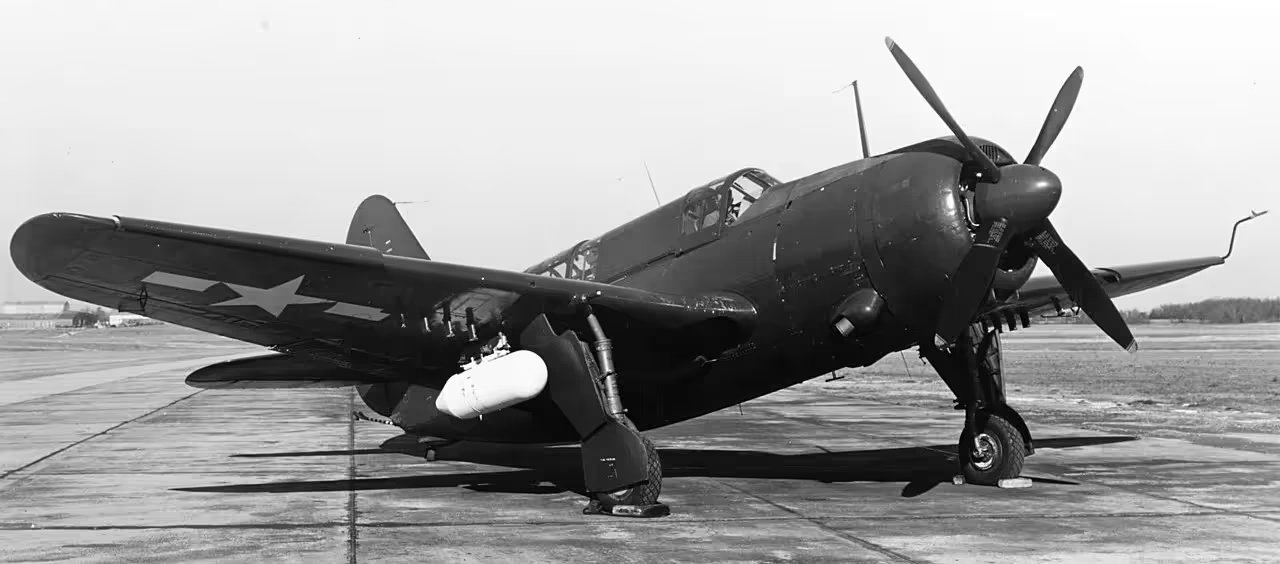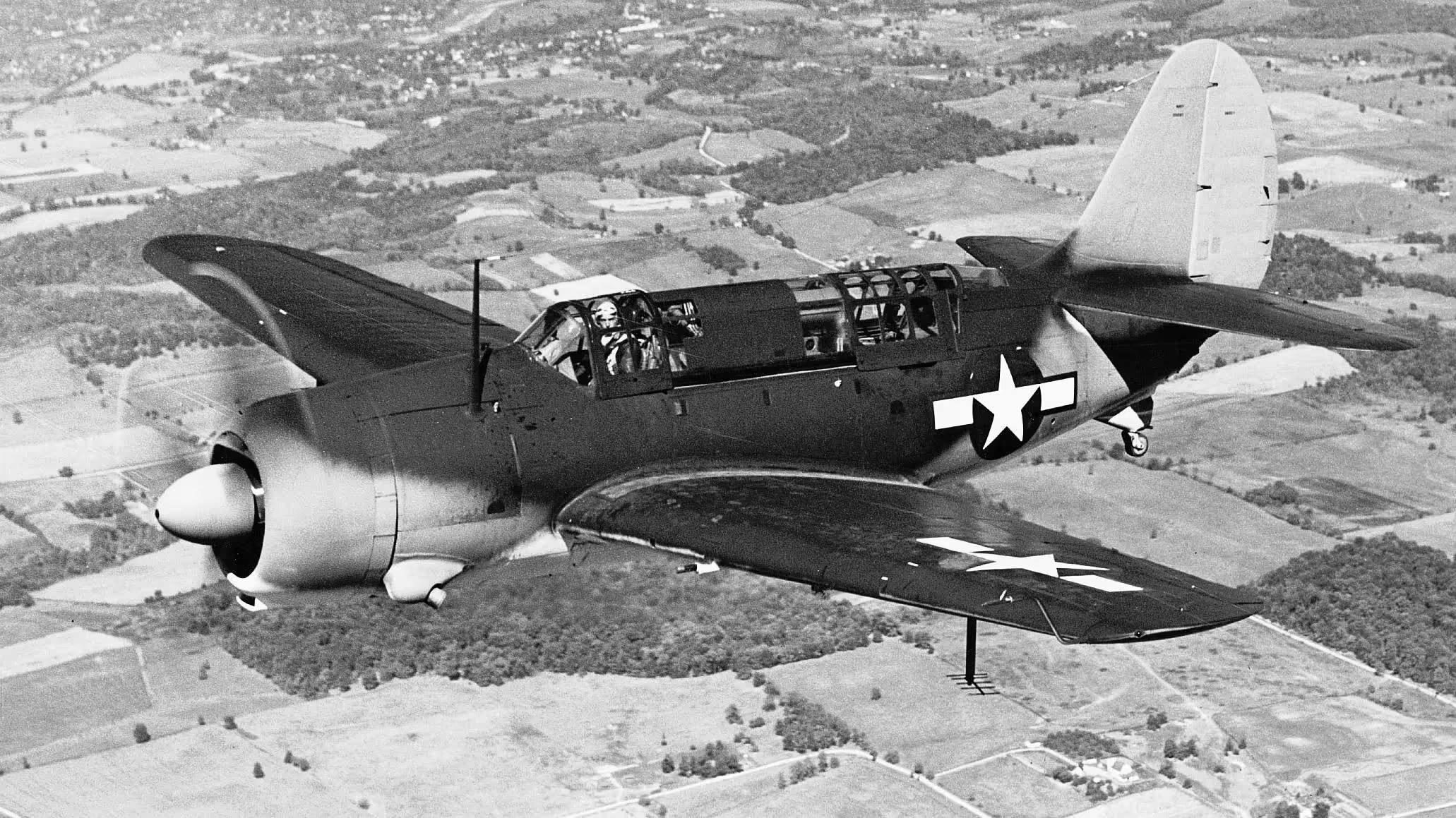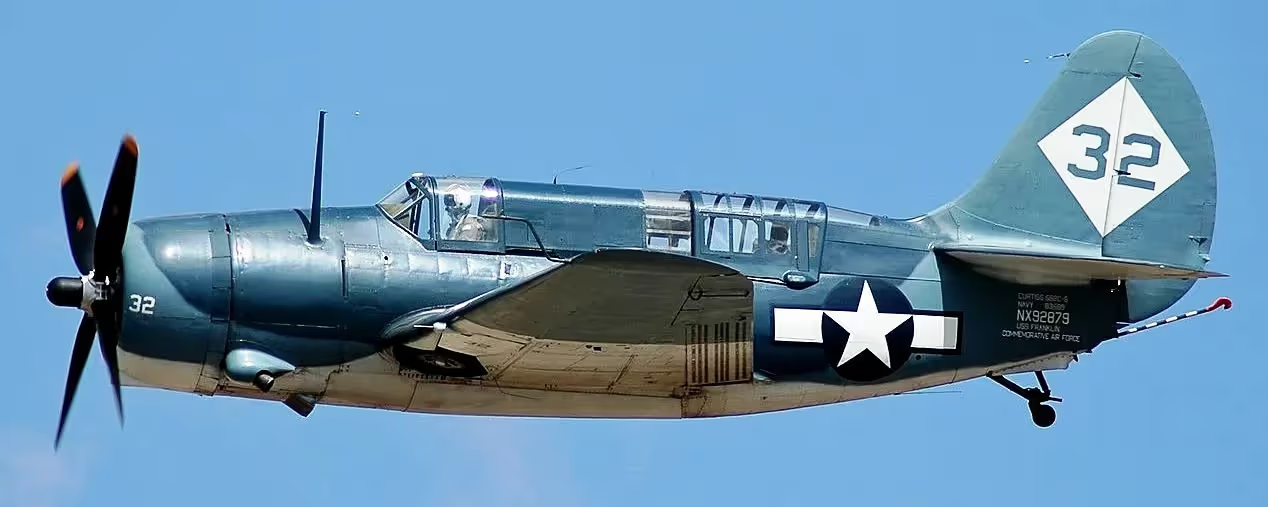Warplanes of the USA: Curtiss SB2C Helldiver
Curtiss SB2C Helldiver

(USN Photo)
The Curtiss SB2C Helldiver is a dive bomber developed by Curtiss-Wright during World War II. As a carrier-based bomber with the United States Navy (USN), in Pacific theaters, it supplemented and replaced the Douglas SBD Dauntless. A few survivors are extant.Initially poor handling characteristics and late modifications caused lengthy delays to production and deployment, to the extent that it was investigated by the Truman Committee, which turned in a scathing report. This contributed to the decline of Curtiss as a company. Neither pilots nor aircraft carrier skippers seemed to like it. Nevertheless, the type was faster than the Dauntless, and by the end of the Pacific War, the Helldiver had become the main dive bomber and attack aircraft on USN carriers.By the time a land-based variant, known as the A-25 Shrike, became available in late 1943, the Western Allied air forces had abandoned dedicated dive-bombers. A majority of A-25s delivered to the US Army Air Forces were transferred to the US Marine Corps, which used the type only in one side campaign and non-combat roles. The British Royal Navy and the Royal Australian Air Force also cancelled substantial orders,[2] retaining only a few aircraft for research purposes.
The Royal Navy, the RAAF, the Greek Air Force, the Portuguese Air Force, the Italian Air Force, the Royal Thai Air Force, and the French Air Force flew Helldivers. Although many were built in Canada, the RCAF did not have them on strength.

(NMNA Photo)
Curtiss SB2C Helldiver of Bombing Squadron Seven (VB-7) in flight over ships of Task Force 38 after completing an attack against Japanese shipping 25 miles north of Quinchon, French Indochina. Note the horseshoe symbol on the tail indicating the aircraft’s assignment to the Hancock and the pillow on rear cockpit gun in order to provide some level of comfort for the gunner on the long flight home.

(USN Photo)
Curtiss SB2C-4 Helldiver, possibly assigned to Utility Squadron 17 (VJ-17) in flight near Guam.

(USN Photo)
Curtiss SB2C Helldiver, coded 82.

(USN Photo)
Curtiss SB2C Helldiver seen on the after flight deck of the aircraft carrier USS Hancock in the western Pacific, Dec 1944. The aircraft’s horseshoe tail geometric identifies it as from Squadron No. 7 from the Hancock.

(USN Photo)
U.S. Navy Fairchild SBF-4E Helldiver (BuNo 31895) at the Naval Air Test Center, Patuxent River, Maryland, 17 December 1945. Fairchild Aircraft Ltd. at Longueuil, Quebec, Canada, a subsidiary of Fairchild Aircraft, built 300 Curtiss SB2C Helldivers under licence, 100 being SB2C-4E.

(USN Photo)
Curtiss SB2C-5 Helldiver (BuNo. 83479). Recently restored, an aircraft like the one shown above is displayed as “208” inside the centre. Built at Columbus, Ohio, this aircraft rolled off the assembly line in May 1945. BuNo. 83479 flew with VB92 on the USS Lexington in the western pacific.
_off_Iwo_Jima.avif)
(USN Photo)
Curtiss SB2C-4 Helldiverser from Bombing Squadron VB-3, Carrier Air Group 3 (CVG-3), assigned to the aircraft carrier USS Yorktown (CV-10), over the invasion fleet, during strikes on Iwo Jima on 22 February 1945. Note Yorktown´s geometric air group identification symbol on the SB2Cs.

(Kogo Photo)
Curtiss SB2C-5 Helldiver (BuNo. 83589), Reg. No. NX92879, Commemorative Air Force (West Texas Wing), Graham, Texas. Airworthy.

(Mys 721tx Photo)
Curtiss SB2C-5 Helldiver (BuNo. 83479), 212. Built at Columbus, Ohio, this aircraft rolled off the assembly line in May 1945. BuNo. 83479 flew with VB92 on the USS Lexington in the western pacific. This aircraft is preserved in the National Air and Space Museum (NASM), Steven F. Udvar-Hazy Center, Washington Dulles International Airport, Chantilly, Virginia.
Curtiss SB2C-3 Helldiver (BuNo. 19075), being restored for the Yanks Air Museum, Chino, California.
Curtiss SB2C-4 Helldiver (BuNo. 19866), being restored for the National Museum of Naval Aviation, NAS Pensacola, Florida.
Curtiss SB2C-5 Helldiver (BuNo. 83393), being restored for Fagen Fighters and Warhawks, Granite Falls, Minnsota.

(USAAF Photo)
USAAF Curtiss A-25 Shrike (Serial No. 41-18787).
Curtiss A-25A Shrike/SB2C-1A Helldiver (BuNo. 75552), being restored for a private owner, Cameron Park, California.
Curtiss A-25A Shrike/SB2C-1A Helldiver (BuNo. 76805), being restored for the National Museum of the USAF, Wright-Patterson AFB, Dayton, Ohio.

(USN Photo)
Curtiss A-25A Shrike (Serial No. A69-4), the only Curtiss Shrike to enter RAAF service

(USN Photo)
A Navy Curtiss Helldiver (SB2C) is snapped against the background provided by its carrier as it returns from a strike at Jap shipping. Far below other planes are being spotted on the flight deck to which the SB2C will soon return.

(USN Photo)
Curtiss SB2C-5 Helldiver from Bombing Squadron 10 (VB-10), Carrier Air Group 10 (CVG-10), assigned to the aircraft carrier USS Intrepid (CV-11), in flight over Tianjin, China, as the city is reoccupied by the Allies, 5 September 1945. Note USS Intepid´s geometric carrier air group identification symbol on the SB2C.

(Archives of Ontario Photo, I0002978)
Curtiss SBW-1 Helldiver, Canadian Car & Foundry, Fort William, Ontario, 29 July 1943.

(RN Photo)
Curtiss SBW-1B Helldiver, RN (Serial No. JW117).

(NMNA Photo)
Curtiss SBW-4E Helldiver, New York Naval Reserve, USN (BuNo. V60166).

(Author Photo, 1982)



(Dimitris Kamaras Photos)
Curtiss SB2C-5 Helldiver (BuNo. 83321). Hellenic Air Force Museum, Decelea Air Base, Greece. This is the last survivor of 48 ex-USN divebombers delivered to Greece in the spring of 1949.
_(14568831439).avif)
(Alec Wilson Photo)
Curtiss SB2C-5 Helldiver, RTAF (Serial No. J3-4/94). Royal Thai Air Force Museum, Don Mueang District, Bangkok, Thailand.
Curtiss SB2C-4 and SB2C-5 Helldivers were flown by the the Portuguese Navy's Aviação Naval (Naval Aviation.

(USN Photo)
A formation of U.S. Navy aircraft from Carrier Air Group 3 (CVG-3) in flight in 1946. In front is a Grumman F6F-5 Hellcat flown by the Air Group Commander (CAG), Cdr. Louis H. Bauer, followed by a Curtiss SB2C-5 Helldiver (from VB-3), a Grumman TBM-3E Avenger (VT-3) and a Grumman F8F-1 Bearcat (VF-3).

(Alan Wilson Photo)
Curtiss SB2C-3 Helldiver (Serial No. 19075), Reg. No. N4250Y. Yanks Air Museum, Chino, California.

(USN Photo)
Curtiss SB2C-4 Helldiver bombers, probably of Marine Scout Bombing Squadron 333 (VMSB-333), pictured at Marine Corps Air Station Ewa, Territory of Hawaii, ca 1945.

(USAAF Photo)
The Civilian Pilot Training Program created opportunities for women to fly. These Women Airforce Service Pilots, or WASPs, got their first aeronautical training through the CPTP. For example, Dr. Dora Dougherty Strother (top) flew a wide variety of missions during the Second World War, including reliability tests of the B-29 Superfortress bomber. She went on to a long career in flying and aircraft engineering, and set women’s records flying rotorcraft.

(USAAF Photo)
Three WASPs on right wing of A-25 checking the flight plan before a tow mission.

(NMNA Photo)
Curtiss SB2C-4 Helldiver assigned to the Air Sea Rescue Unit at Naval Air Station Kaneohe, Territory of Hawaii, ca 1945.

(USN Photo)
Curtiss SB2C-1 Helldiver, VB-17, being waved off USS Bunker Hill in 1943.

(USN Photo)
The incident involving the aircraft carrier USS Bunker Hill (CV-17) occurred on May 11, 1945, during the Battle of Okinawa, one of the final and most intense naval battles of the Second World War in the Pacific theatre.Bunker Hill was struck by two kamikaze aircraft in quick succession, causing a devastating fire that lasted for hours and resulted in significant casualties. At approximately 10:00 AM, a Japanese kamikaze aircraft, a Yokosuka D4Y or "Judy" dive bomber, crashed into the port side of the carrier's flight deck, causing an immediate explosion.While the crew was still recovering from that hit, a second kamikaze aircraft, a Mitsubishi A6M Zero fighter, crashed into the starboard side of the flight deck. This second attack ignited a massive fire, which spread quickly through the ship.The fire caused by the kamikaze strikes was particularly devastating due to the presence of bomb and ammunition stores on board, creating numerous secondary explosions.The explosions and the raging fire killed 393 crew members and injured 264 more. The Bunker Hill was severely damaged, with much of the flight deck destroyed, but despite the extensive damage, the ship remained afloat. The photo of the Bunker Hill fire was taken from the USS Bataan (CVL-29), a light aircraft carrier that was operating nearby. The Bataan had been involved in the same battle and was providing support to the larger fleet. The image captures the catastrophic nature of the fire and serves as a stark reminder of the fierce combat conditions that were prevalent in the Pacific during the final months of the war. Despite the severity of the damage, the USS Bunker Hill was able to return to the United States for repairs, though it remained out of action for several months. The kamikaze attack on the Bunker Hill exemplified the intensity of Japan's final, desperate efforts to inflict damage on the U.S. Navy as the war neared its end. (USN)

(Naval History and Heritage Command Photo, NH 51018)
Curtiss SB2C Helldiver on the deck of USS Kwajalein (CVE-98) during a typhoon, December 1944.

(National Archives and Records Administration Photo)
Curtiss XSB2C-1 Helldiver with a 2,000-lb bomb being wheeled towards it.

(USN Photo)
Curtiss XSB2C-2 floatplane, the only example built, 29 Sep 1942.

(USN Photo)
Curtiss SB2C Helldiver, painted canary yellow, at the Naval Air Modification Unit, Johnsville, Pennsylvania.





